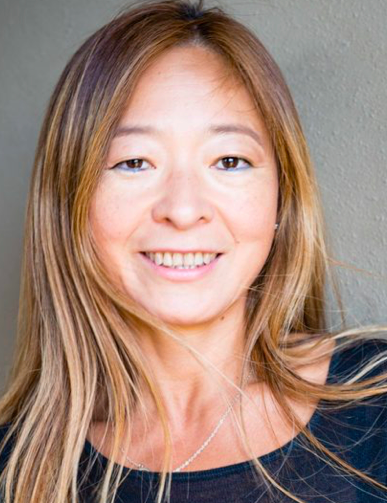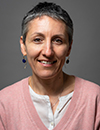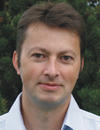08:00 | Conference Registration and Morning Coffee |
|
Session Title: Conference Opening Session |
| |
09:00 |  | Keynote Presentation Detection of Antibodies Against SARS-CoV-2 Spike Protein by Gold Nanospikes in an Optomicrofluidic Chip
Amy Shen, Professor and Provost, Okinawa Institute of Science and Technology Graduate University, Japan
The ongoing global pandemic of severe acute respiratory syndrome coronavirus 2 (SARS-CoV-2) has led to active research in its associated diagnostics and medical treatments. While quantitative reverse transcription polymerase chain reaction (qRT--PCR) is the most reliable method to detect viral genes of SARS-CoV-2, serological tests for specific antiviral antibodies are also important as they identify false negative qRT--PCR responses, track how effectively the patient's immune system is fighting the infection, and are potentially helpful for plasma transfusion therapies. In this work, based on the principle of localized surface plasmon resonance (LSPR), we develop an optomicrofluidic sensing platform with gold nanospikes, fabricated by electrodeposition, to detect the presence and amount of antibodies specific to the SARS-CoV-2 spike protein in 1 uL of human plasma diluted in 1 mL of buffer solution, within ~30~min. The target antibody concentration can be correlated with the LSPR wavelength peak shift of gold nanospikes caused by the local refractive index change due to the antigen-antibody binding. This label-free microfluidic platform achieves a limit of detection of ~0.08~ng/mL (~0.5~pM), falling under the clinical relevant concentration range. We demonstrate that our opto-microfluidic platform offers a promising point-of-care testing tool to complement standard serological assays and make SARS-CoV-2 quantitative diagnostics easier, cheaper, and faster.
|
|
09:30 |  | Keynote Presentation Using Microfluidics for Non-Invasive Cancer Diagnosis
Lorena Diéguez, Leader of the Medical Devices Research Group, INL- International Iberian Nanotechnology Laboratory, Portugal
Microfluidics presents numerous advantages for the handling of biological samples, as it provides careful control of fluids in the microscale. When it comes to biomarkers enrichment, microfluidics has demonstrated superior sensitivity and enhanced recovery compared to traditional methods. Incorporating sensors, lab-on-a-chip technologies offer efficient characterization of disease biomarkers from body fluids, making microfluidics ideal for clinical practice, enabling high throughput, portability, and automation. Early dissemination of cancer is difficult to detect by traditional imaging and pathological methods. While the presence of cancer material in body fluids is well known, current techniques for the isolation, analysis and characterization of these biomarkers are not efficient enough to be fully applied in clinical routine. In this talk, we present our work for isolation and multiplex analysis of cancer biomarkers from body fluids based on microfluidics, and biosensors towards personalized medicine and earlier diagnosis of cancer. |
|
10:00 |  | Keynote Presentation Novel Organoid Models to Develop Drug Treatment Strategies
Robert Vries, CEO, HUB Organoids, Netherlands
Organoids such as IPSC derived brain organoids (Lancaster et al Nature
2013) or our adults epithelial stem cell derived organoids (Sato et al.,
Nature 2009, 2011) are proving to be a major breakthrough in
preclinical models. The new patient like models are fundamental change
in the way drug discovery and development can be performed. The
development of the HUB Organoids started in the lab of Hans Clevers with
the discovery of the identity of adult stem cells in human epithelial
tissues such as intestine and liver (Barker et al., Nature 2007; Huch et
al., Nature 2013). With the identification of these stem cells, we were
able to develop a culture system that allowed for the virtually
unlimited, genetically and phenotypically stable expansion of the
epithelial cells from animals including humans, both from healthy and
diseased tissue (Sato et al., Nature 2009, 2011; Gastroenterology 2011;
Huch et al., Nature 2013, Cell 2015; Boj et al., Cell 2015).
We
have now generated HUB organoid models from most epithelial organs.
Recently, we and others have demonstrated that the in vitro response of
organoids correlates with the clinical outcome of the patient from which
the organoid was derived (Dekkers et al., Sci Trans Med 2016; Sachs et
al., Cell 2018; Vlachogiannis et al., Science 2018). In addition, we
have developed a coculture system using HUB Organoids and the immune
system to study this interaction and drugs that target the role of the
immune system in cancer and other diseases.
We have recently
developed new models to study intestinal and lung barrier function and
transport of the epithelium of these organs. These experiments show how
organoids can be used to study mechanism that underly barrier function
disruption in IBD or COPD. Furthermore, we have developed new models to
study the interaction between immune system and epithelium. The
combination of the new coculture models and assay development to study
the epithelium allows us new insights into disease mechanisms and drug
treatment strategies. |
|
10:30 | Morning Coffee Break and Networking in the Exhibit Hall |
11:00 |  | Keynote Presentation Droplet-based Microfluidics for Cancer Research
Valérie Taly, CNRS Research Director, Professor and Group leader Translational Research and Microfluidics, Université Paris Cité, France
Droplet-based microfluidics has led to the development of highly powerful tools with great potential in High-Throughput Screening where individual assays are compartmentalized within aqueous droplets acting as independent microreactors. Thanks to the combination of a decrease of assay volume and an increase of throughput, this technology goes beyond the capacities of conventional screening systems. Added to the flexibility and versatility of platform designs, such progresses in the manipulation of sub-nanoliter droplets has allowed to dramatically increase experimental level of control and precision. The presentation will aim at demonstrating through selected example, the great potential of this technology for biotechnology and cancer research. A first part of the presentation will exemplify how microfluidic systems can be used to compartmentalize and assay various types of cells without deleterious effects on their viability within complex and controlled platforms. The application of microfluidic systems for different cell-based assays will be demonstrated. Illustrative examples of droplet-based microfluidic platforms with high potential impact for cancer research will be presented. We will also show how by combining microfluidic systems and clinical advances in molecular diagnostic we have developed an original method to perform millions of single molecule PCR in parallel to detect and quantify a minority of target sequences in complex mixture of DNA with a sensitivity unreachable by conventional procedures. To demonstrate the pertinence of our procedures to overcome clinical oncology challenges, the results of clinical studies will be presented. |
|
11:30 |  | Keynote Presentation Self-Coalescing Flows: A Powerful Method For Integrating Biochemical Reactions In Portable Diagnostic Devices
Emmanuel Delamarche, Manager Precision Diagnostics, IBM Research - Zürich, Switzerland
Diagnostics are ubiquitous in healthcare because they support
prevention, monitoring, and treatment of diseases. Specifically,
point-of-care diagnostics (POCDs) are particularly attractive for
identifying diseases near patients, quickly, and in many settings and
scenarios. POCDs can also trace exposure and acquired immunity of
populations exposed to infectious diseases and screen metabolic
deficiencies of individuals, who may be exposed to severe drug side
effects. However, a long-standing challenge with POCDs is the need to
integrate reagents in closed devices for a large number of potential
applications. Following our previous contributions on developing
capillary-driven microfluidic chips for highly miniaturized
immunoassays, controlling and monitoring flow with nanoliter precision,
and securing diagnostics against counterfeiting with dynamic optical
security codes, we recently demonstrated how to shape and fold liquids
inside microfluidic chambers to dissolve reagents with extreme
precision. In this presentation, I will explain the underlying concept
of this method, called self-coalescing flows, and will illustrate how it
can be used to perform various assays, ranging from enzymatic assays,
to immunoassays and molecular assays. Despite self-coalescing flows
being still an open research topic in fluid physics, their
implementation is surprisingly facile and robust and therefore may
benefit the entire community working on POCDs. |
|
12:00 |  | Keynote Presentation Nervous Systems-on-a-Chip: From Technology to Applied Biomedical Sciences
Regina Luttge, Professor, Eindhoven University of Technology, Netherlands
Challenges in eavesdropping on the complex cell signaling of the human
central nervous system is an essential driver for the development of
advanced in vitro technologies, called Brain-on-a-Chip. Developments in
Brain-on-a-Chip technology focus primarily on the implementation of
cortical cells from human stem cell source in a 3D cultured
microenvironment. The aim of a recently launched EU project CONNECT is
to mimic the in vivo functions of the nervous system in one connected
chip system. The creation of new neurodegenerative disease models in
this project brings together the knowledge accumulated among
neuroscientists, stem cell experts and engineers to investigate the
origins and possible treatments for Parkinson's disease. In this
presentation, we will discuss in detail the technical approach of a
nervous system on a chip as a unique tool for modelling the neural
pathway of connected tissues on the brain-gut axis. In addition to
design criteria for these microliter-sized physiological cell culture
systems, the presentation will focus on guidance of the growth process
of axon protrusions and the local control of cell differentiation
processes while maintaining physiological conditions. |
|
12:30 | Networking Lunch, Exhibits and Poster Viewing |
13:30 |  Scaling up for High Volume Chip Production Scaling up for High Volume Chip Production
Chris Walker, Director, Microfluidics & Medical Converting Equipment Markets, Preco, Inc.
The benefits of working in automated LOC production are presented, using the method of compiling polymer foil/film and adhesive substrates, alongside discrete lateral flow components with the equipment employed for increasing rates of manufacture.
|
15:30 | Afternoon Coffee Break in the Exhibit Hall |
|
Session Title: Current Themes and Trends in Microfluidics Research |
| |
16:00 |  HIGH QUALITY PROTOTYPING as a Bridge to Product Development at STRATEC Consumables HIGH QUALITY PROTOTYPING as a Bridge to Product Development at STRATEC Consumables
Matthias Mösl, Team Leader Protowerk , STRATEC Consumables GmbH
The vast majority of developmental projects for life science and IVD applications require early prototyping. Therefore, the early involvement of injection molding companies like STRATEC Consumables, is becoming more and more important. STRATEC’s focus is on providing an outstanding quality of micro- and nanostructures as well as enabling a smooth transition from early prototyping to mass manufacturing later on. This is supported by specialized design workshops, clearly defined processes applications and sophisticated materials, which are suitable for subsequent mass manufacturing.
|
16:30 | Manipulating Liquids with Shaped Acoustic Fields – Applications In Medical Diagnostics and Drug Delivery
Jonathan Cooper, The Wolfson Chair of Bioengineering, University of Glasgow, United Kingdom
Recently, pressure driven flow through the use of surface acoustic waves (SAWs) has attracted much attention. To better control the nature of the acoustic field when using SAWs, we have introduced the concept of using frequency dependent periodic arrays known as phononic crystals within microfluidics. In doing so, we have enabled new "acoustic holograms" that result in waveguiding, reflectors, bandgaps and lenses, that shape the ultrasonic field and create new microfluidic flows. We are able to demonstrate how we can create interesting new fluidic phenomena including the creation of liquid lenses, enabling the imaging of nanoparticles, including viruses, using a mobile phone camera. This level of precise control over liquid flows has also opened up other fields of study including new applications in drug delivery and diagnostics. |
17:00 |  Sense and Sensibility: A Tale of Complexity in Commercial Microfluidic Device Production Sense and Sensibility: A Tale of Complexity in Commercial Microfluidic Device Production
Holger Becker, Chief Scientific Officer, Microfluidic ChipShop
|
17:30 | Close of Day 1 of the Conference |









